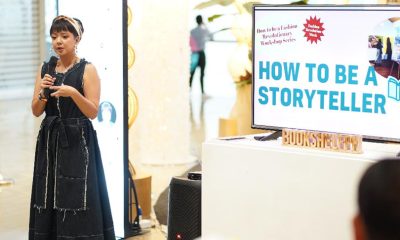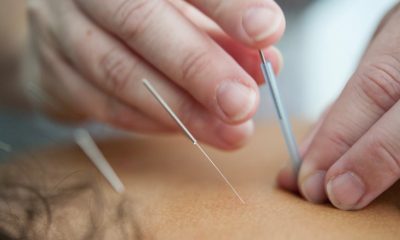NewsMakers
Wearing surgical masks in public could help slow COVID-19 pandemic’s advance
Other measures found more effective than masks include improving ventilation in public places like grocery stores, or installing UV-C lights near the ceiling that works in conjunction with ceiling fans to pull air upwards and destroy viruses and bacteria.

Surgical masks may help prevent infected people from making others sick with seasonal viruses, including coronaviruses, according to new research that could help settle a fierce debate spanning clinical and cultural norms.
In laboratory experiments, the masks significantly reduced the amounts of various airborne viruses coming from infected patients, measured using the breath-capturing “Gesundheit II machine” developed by Dr. Don Milton, a professor of applied environmental health in the University of Maryland School of Public Health and a senior author of the study published April 3 in the journal Nature Medicine.
Milton has already conferred with federal and White House health officials on the findings, which closely follow statements this week from the head of the Centers for Disease Control and Prevention saying the agency was reconsidering oft-stated advice that surgical masks aren’t a useful precaution outside of medical settings. (The debate takes place at a time when clinicians themselves face dangerously inadequate supplies of masks–a shortfall other UMD researchers are scrambling to help solve.)
The question of masks has roiled society as well, with some retailers refusing to let employees wear them for fear of sending negative signals to customers, and cases of slurs and even physical attacks in the United States and elsewhere against Asians or Asian Americans who were wearing masks, a measure some consider a necessity during a disease outbreak.
The study, conducted prior to the current pandemic with a student of Milton’s colleagues on the Faculty of Medicine at the University of Hong Kong, does not address the question of whether surgical masks protect wearers from infection. It does suggest that masks may limit how much the infected–who in the case of the novel coronavirus often don’t have symptoms–spread diseases including influenza, rhinoviruses and coronaviruses.
Milton, who runs the Public Health Aerobiology, Virology, and Exhaled Biomarker Laboratory in the School of Public Health, demonstrated in a 2013 study that surgical masks could help limit flu transmission. However, he cautions that the effect may not be as great outside of controlled settings.
Nevertheless, he said, the chance they could help justifies taking a new look at whether all people should be encouraged to wear them when they venture out of their houses to stores or other populated locations during the current COVID-19 lockdown.
“In normal times we’d say that if it wasn’t shown statistically significant or the effective in real-world studies, we don’t recommend it,” he said. “But in the middle of a pandemic, we’re desperate. The thinking is that even if it cuts down transmission a little bit, it’s worth trying.”
Previous studies have shown that coronavirus and other respiratory infections are mostly spread during close contact, which has been interpreted by some infectious disease specialists to mean that the disease could spread only through contact and large droplets, such as from a cough or sneeze–a message that has often been shared with the public.
“What they don’t understand is that is merely a hypothesis,” Milton said. The current study (along with earlier ones) shows, by contrast, that tiny, aerosolized droplets can indeed diffuse through the air. That means it may be possible to contract COVID-19 not only by being coughed on, but by simply inhaling the breath of someone nearby who has it, whether they have symptoms or not. Surgical masks, however, catch a lot of the aerosolized virus as it’s exhaled, he said.
The study was conducted at the University of Hong Kong as part of the dissertation research of the lead author, Dr. Nancy Leung, who, under the supervision of the co-senior authors Drs. Cowling and Milton, recruited 246 people with suspected respiratory viral infections. Milton’s Gesundheit machine compared how much virus they exhaled with and without a surgical mask.
“In 111 people infected by either coronavirus, influenza virus or rhinovirus, masks reduced detectable virus in respiratory droplets and aerosols for seasonal coronaviruses, and in respiratory droplets for influenza virus,” Leung said. “In contrast, masks did not reduce the emission of rhinoviruses.”
Although the experiment took place before the current pandemic, COVID-19 and seasonal coronaviruses are closely related and may be of similar particle size. The report’s other senior author, Professor Benjamin Cowling, division head of epidemiology and biostatistics, School of Public Health, HKUMed, and co-director of the World Health Organization Collaborating Centre for Infectious Disease Epidemiology and Control, said, “The ability of surgical masks to reduce seasonal coronavirus in respiratory droplets and aerosols implies that such masks can contribute to slowing the spread of (COVID-19) when worn by infected people.”
Milton pointed to other measures his research has found is even more effective than masks, such as improving ventilation in public places like grocery stores, or installing UV-C lights near the ceiling that works in conjunction with ceiling fans to pull air upwards and destroy viruses and bacteria.
“Personal protective equipment like N95 masks are not our first line of defense,” Milton said. “They are our last desperate thing that we do.”
Hong Kong University contributed to this report.
NewsMakers
Cardio-fitness cuts death and disease by nearly 20%
Running, cycling, or swimming – if you regularly exercise, you’re on track for a long and healthy life.

Running, cycling, or swimming – if you regularly exercise, you’re on track for a long and healthy life.
This is according to a study – “Cardiorespiratory fitness is a strong and consistent predictor of morbidity and mortality among adults: an overview of meta-analyses representing over 20.9 million observations from 199 unique cohort studies” – that was published in the British Journal of Sports Medicine.
The study comprised of 26 systematic reviews with meta-analysis representing more than 20.9 million observations from 199 unique cohort studies. It is the first study to collate all the scientific evidence that looked at the prospective link between cardiorespiratory fitness and health outcomes among adults.
The study found that:
- for every 1-MET increase in cardiorespiratory fitness – the amount of energy used for quiet sitting – a person can reduce their risk of death by 11-17%, and specifically, their risk of heart disease by 18%.
- an increased cardio fitness level will reduce your risk of death from any cause by 11-17%.
Senior author Grant Tomkinson said that cardiorespiratory fitness is probably the most important type of fitness for good health. “Cardiorespiratory fitness (or CRF) is your ability to perform physical activity for a long period of time like running, cycling, and swimming. And in this study, we found prolonged cardiorespiratory fitness is strongly and consistently associated with all types of premature death and incident disease – spanning heart failure, depression, diabetes, dementia and even cancer.”
Tomkinson added that the researchers “summarized the evidence linking CRF to numerous health outcomes and found that those with low levels of CRF are far more likely to die early or develop chronic conditions like heart disease later in life.” Specifically, “we found that every 1-MET increase in CRF, which is the amount of energy used when sitting quietly, reduced the risk of early death from any cause and heart failure by 11–17% and 18%, respectively. For most people, a 1-MET increase in CRF can be achieved through a regular aerobic exercise program.”
For Tomkinson, the message is quite simple: if you do a lot of “huff and puff” exercise, then your risk of dying early or developing diseases in the future is reduced. If you avoid exercise your health may suffer.
Chronic health conditions are an ongoing cause of poor health, disability, and premature death. In Australia, an estimated 11.6 million people (47%) have a chronic and debilitating health conditions, which contributes to two thirds of the burden of disease.
“Clearly, cardiorespiratory fitness is as an important factor for good health. If you are already exercising, this is good news; but if you know you need to up your fitness and movement, then this is a timely reminder,” co-author Dr Justin Lang said.
“People can make meaningful improvements through additional moderate physical activity, such as brisk walking, at least 150 minutes a week. And as they improve their fitness, their risk of death and disease will decline. But the onus for improvement should not just sit with the individual, it should also be routinely assessed in clinical and public health practice, so that we can support people to improve their health outcomes,” Lang added.
Through regular assessment, clinicians and exercise professionals could better identify adults at greater risk of early death and initiate exercise programs aimed at increasing CRF through regular physical activity.
NewsMakers
New Pru Life UK CEO pays courtesy visit to insurance commissioner
Providing financial protection to the Muslim community is another key priority of the Commission, to which Pru Life UK pledged its support and commitment.

Pru Life UK’s newly appointed CEO Sanjay Chakrabarty met with the Insurance Commissioner Atty. Reynaldo Regalado (right) to reinforce the company’s commitment and support to the Insurance Commission’s goal to advance financial literacy & inclusion in the country, and good governance in the insurance sector.
Strengthening their commitment to providing better financial protection for Filipino families, IC Commissioner Regalado and Chakrabarty shared their insights and plans to bolster financial literacy initiatives, improve governance standards, and expand access to insurance products, particularly among vulnerable and underserved populations. Providing financial protection to the Muslim community is another key priority of the Commission, to which Pru Life UK pledged its support and commitment.
“It was an honor to meet Insurance Commissioner Atty. Reynaldo Regalado and reinforce Pru Life UK’s commitment to achieving our shared goals of increasing insurance penetration in the Philippines and elevating good governance in the life insurance industry,” Chakrabarty shares.
Pru Life UK is the leading life insurer in the Philippines, recording the highest New Business Annual Premium Equivalent (NBAPE) in 2023, according to the Insurance Commission’s latest report as of 31 December 2023.
NewsMakers
Red Bull Half Court national finals now in full swing
“Red Bull provided a lot of opportunities for the basketball community in the Philippines, from Cebu, (to) Davao, and here in Manila. It really is a great help for all of the players and we hope that Red Bull will continue this event (Red Bull Half Court) every year or even better if possible twice or thrice a year for everyone to play and participate,” said Almond Vosotros from TNT Tropang Giga.

The Philippines has locked in its representatives to compete at the Red Bull Half Court 2024 in New York City, USA, following the last regional showdown in Manila last April 27 at the Bonifacio Shrine.
The journey to make it to this point has been nothing short of spectacular and exciting, as teams from across the country displayed incredible sportsmanship, skill, and resilience on the court. From thrilling buzzer-beaters to jaw-dropping dunks, the Red Bull Half Court series this year has been fierce, and yet only the top twenty four teams: eight men’s qualifying teams, eight men’s wildcard teams, four women’s qualifying teams, and four wildcard teams, were left to compete at the Red Bull Half Court 2024 National Finals.
Last April 27, the qualifying teams with dreams to compete in New York battled it out in the court. Actor and basketball enthusiast Gerald Anderson was in attendance with his team, 3rd Floor. After advancing through the Pool Phase and facing off against four other teams, they reached the Quarter Finals. Despite a valiant effort, they were bested by TNT Tropang Giga with a score of 12-11.
“It was recommended to me. I was looking for a basketball event to compete in and Red Bull Half Court was perfect,” Gerald Anderson said, explaining how he came to know about the event. “Red Bull Half Court is intense,” he commented. “(It’s) very hot due to the intense heat, but overall the concept is great for everyone.”
In the end, Almond Vosotros, Levin Flores, Chester Saldua, and Matt Salem of TNT Tropang Giga and Sam Harada, Kaye Pingol, Eunique Chan, and Afril Bernardino of Uratex Dream earned the prestigious chance to represent the Philippines on the global stage for the Red Bull Half Court 2024 World Finals. Their hard work and dedication have evidently paid off, and these attributes brought them one step closer to their ultimate goal.
“Red Bull provided a lot of opportunities for the basketball community in the Philippines, from Cebu, (to) Davao, and here in Manila. It really is a great help for all of the players and we hope that Red Bull will continue this event (Red Bull Half Court) every year or even better if possible twice or thrice a year for everyone to play and participate,” said Almond Vosotros from TNT Tropang Giga.
Kaye Pingol from Uratex Dream expressed their gratitude and enthusiasm to Red Bull for providing women an opportunity to be seen in a bigger stage, “Red Bull Half Court is a big win for our team, especially (since) women’s basketball isn’t often seen or given a bigger platform here in the Philippines.”
In addition to the thrilling matchups on the court, the Red Bull Half Court 2024 National Finals also featured performances by the Philippine All Stars, Pricetagg, Zae and DJ Razikyle. Their electrifying routines brought an extra dimension of entertainment to the event, showcasing not only the incredible agility but also the vibrant cultural scene of the Philippines.
Moreover, amidst the basketball action and artistic performances, attendees were treated to an art showcase by Raco Ruiz. His unique artistic vision brought a touch of creativity and flair to the event. Red Bull’s collaboration with Raco Ruiz and the Manila LGU extended to the revamping of a chosen basketball court for a local community in Manila, including painting a mural for the floor and hoop backstops. Adding to the spectacle, live art demonstrations on the hoop backstops further enriched the atmosphere, and highlighted both sports and artistry in the country.
With their heads held high, the winning teams, TNT Tropang Giga and Uratex Dream now prepare to be the Philippine representatives at the Red Bull Half Court 2024 World Finals, where they’ll face off against formidable teams from different regions.
“This is a really big opportunity, not only for us but women’s basketball in general, to have an opportunity to showcase our talent, and we are extremely happy that we won and will be representing the Philippines in New York,” said Kaye Pingol of Uratex Dream.
The Red Bull Half Court 2024 World Finals will take place in New York this October, where the best street basketball talent from around the globe will battle it out in an unforgettable series of tournaments. As each team prepares for their next challenge, they carry with them the hopes and dreams of a nation united by the love of the game.
-

 NewsMakers1 week ago
NewsMakers1 week ago‘Always be Chic by Miss Kayce’ launched
-

 Beauty & Fashion3 weeks ago
Beauty & Fashion3 weeks agoUNIQLO Mall of Asia store reopens on May 17
-

 Destinations4 weeks ago
Destinations4 weeks agoSingapore Cable Car launches world’s first Skyorb Cabins
-

 Destinations4 weeks ago
Destinations4 weeks agoJapan ranks as top leisure travel destination for Filipino travellers: Visa study
-

 NewsMakers1 week ago
NewsMakers1 week agoI.E. Medica and MedEthix win healthcare awards in Singapore
-

 NewsMakers3 weeks ago
NewsMakers3 weeks agoAerobic exercise can help fight liver diseases
-

 NewsMakers3 weeks ago
NewsMakers3 weeks agoGolden Visa Centrale to hold consultation roadshow on Greek Golden Visa program
-

 NewsMakers3 weeks ago
NewsMakers3 weeks agoAlcohol raises heart disease risk, particularly among women






















